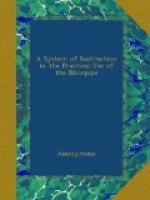(d.) Oxidation.—The chemical combination of any substance with oxygen is termed oxidation, and the products are termed oxides. As these oxides have qualities differing from those which are non-oxidized, it therefore frequently becomes necessary to convert substances into oxides; or, if they are such, of a lower degree, to convert them into a higher degree of oxidation. These different states of oxidation frequently present characteristic marks of identity sufficient to enable us to draw conclusions in relation to the substance under examination. For instance, the oxidation of manganese, of arsenic, etc. The conditions necessary for oxidation, are high temperature and the free admission of air to the substance.
If the oxidation is effected through the addition of a substance containing oxygen (for instance, the nitrate or chlorate of potash) and the heating is accompanied by a lively deflagration and crackling noise, it is termed detonation. By this process we frequently effect the oxidation of a substance, and thus we prove the presence or the absence of a certain class of substances. For instance, if we detonate (as it is termed by the German chemists) the sulphide of antimony, or the sulphide of arsenic with nitrate of potash, we get the nitrate of antimony, or the nitrate of arsenic. The salts of nitric or chloric acid are determined by fusing them with the cyanide of potassium, because the salts of these acids detonate.
(e.) Reduction.—If we deprive an oxidized substance of its oxygen, we term the process reduction. This is effected by fusing the substance under examination with another which possesses a greater affinity for oxygen. The agents used for reduction are hydrogen, charcoal, soda, cyanide of potassium, etc. Substances generally, when in the unoxidized state, have such characteristic qualities, that they cannot very readily be mistaken for others. For this reason, reduction is a very excellent expedient for the purpose of discerning and classifying many substances.
B. UTENSILS.
We shall give here a brief description of the most necessary apparatus used for analysis in the dry way, and of their use.
The Blowpipe is a small instrument, made generally out of brass, silver, or German silver, and was principally used in earlier times for the purpose of soldering small pieces of metals together. It is generally made in the form of a tube, bent at a right angle, but without a sharp corner. The largest one is about seven inches long, and the smallest about two inches. The latter one terminates with a small point, with a small orifice. The first use of the blowpipe that we have recorded is that of a Swedish mining officer, who used it in the year 1738 for chemical purposes, but we have the most meagre accounts of his operations. In 1758 another Swedish mining




